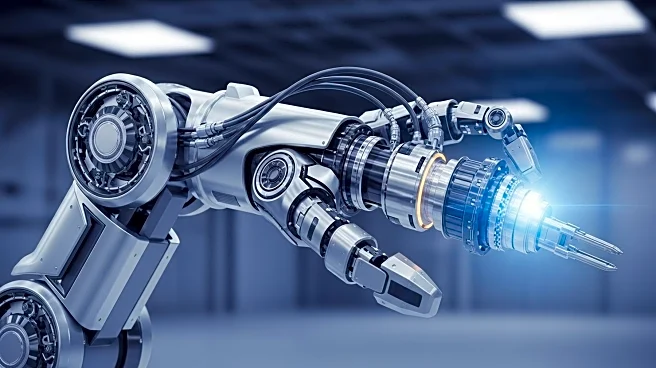What is the story about?
What's Happening?
China is rapidly advancing in the field of robotics, positioning itself as a leader in the global technology race. The country has invested heavily in robotics, resulting in significant developments such as robot dogs, humanoid helpers, and fully automated factories. According to a report by the International Federation of Robotics, China installed nearly 300,000 robots in its factories last year, surpassing the rest of the world combined. This surge in robotics is supported by China's comprehensive supply chain, which allows for rapid prototyping and production. The country is also addressing its labor shortage with AI and robotics, deploying these technologies on factory floors to collect data and train robots. Public enthusiasm and policy support are further driving these advancements, as seen in events like the World Artificial Intelligence Conference and the World Humanoid Robot Games.
Why It's Important?
China's advancements in robotics have significant implications for global technology leadership. As China continues to innovate and deploy robotics, it challenges the United States' position in the tech industry. The U.S. still holds advantages in software and AI chips, but China's dominance in robot hardware and deployment could shift the balance. This development impacts industries reliant on robotics, such as manufacturing and logistics, potentially leading to increased competition and innovation. Additionally, China's focus on vertical integration and domestic production may influence global supply chains and trade dynamics. The rise of Chinese robotics could also affect labor markets, as automation addresses workforce shortages and changes employment patterns.
What's Next?
China's robotics industry is poised for further expansion, with many companies aiming to enter international markets, including the United States. This expansion is driven by competitive pressures at home and the desire to showcase 'Made in China' as a mark of quality. The U.S. may need to invest in infrastructure and joint ventures to bolster its robotics capabilities and maintain competitiveness. Additionally, policy adjustments, such as improved immigration policies and support for fundamental research, could enhance the U.S.'s ability to compete in the robotics sector. As Chinese companies continue to innovate and expand, the global tech landscape may experience shifts in leadership and collaboration.
Beyond the Headlines
The rise of Chinese robotics presents ethical and cultural considerations, particularly regarding automation's impact on employment and society. As robots become more integrated into daily life, questions about privacy, security, and human-robot interaction may arise. Furthermore, China's approach to robotics, emphasizing domestic talent and production, contrasts with Western models that often rely on international collaboration. This divergence could influence global tech culture and innovation strategies. Long-term, the proliferation of humanoid robots may redefine human roles in various sectors, prompting discussions on the future of work and societal adaptation.
AI Generated Content
Do you find this article useful?














